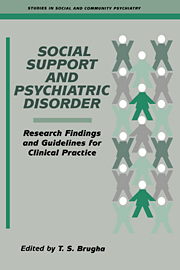Crossref Citations
This Book has been
cited by the following publications. This list is generated based on data provided by Crossref.
Fagin, Leonard
Carson, Jerome
Leary, John
De Villiers, Nicolette
Bartlett, Heather
O'Malley, Patty
West, Maria
Mcelfatrick, Stephen
and
Brown, Daniel
1996.
Stress, Coping and Burnout in Mental Health Nurses: Findings From Three Research Studies.
International Journal of Social Psychiatry,
Vol. 42,
Issue. 2,
p.
102.
Carson, Jerome
Fagin, Leonard
Bromn, Daniel
Leary, John
and
Bartlett, Heather
1997.
Self-esteem in mental health nurses: Its relationship to stress, coping and burnout.
NT Research,
Vol. 2,
Issue. 5,
p.
361.
Becker, Thomas
Thornicroft, Graham
Leese, Morven
McCrone, Paul
Johnson, Sonia
Albert, Maya
and
Turner, David
1997.
Social networks and service use among representative cases of psychosis in South London.
British Journal of Psychiatry,
Vol. 171,
Issue. 1,
p.
15.
Kissane, David W
1998.
Models of Psychological Response to Suffering.
Progress in Palliative Care,
Vol. 6,
Issue. 6,
p.
197.
Albert, Maya
Becker, Thomas
Mccrone, Paul
and
Thornicroft, Graham
1998.
Social Networks and Mental Health Service Utilisation - a Literature Review.
International Journal of Social Psychiatry,
Vol. 44,
Issue. 4,
p.
248.
Edwards, Angela C.
Nazroo, James Y.
and
Brown, George W.
1998.
Gender differences in marital support following a shared life event.
Social Science & Medicine,
Vol. 46,
Issue. 8,
p.
1077.
Becker, Th.
and
Sartorius, N.
1999.
Psychiatrie der Gegenwart 1.
p.
473.
Kitamura, Toshinori
Kijima, Nobuhiko
Watanabe, Kyoko
and
Takezaki, Yoshie
1999.
Precedents of perceived social support: Personality and early life experiences.
Psychiatry and Clinical Neurosciences,
Vol. 53,
Issue. 6,
p.
649.
Harris, Tirril
Brown, George W
and
Robinson, Ruth
1999.
Befriending as an intervention for chronic depression among women in an inner city.
British Journal of Psychiatry,
Vol. 174,
Issue. 3,
p.
225.
Tsang, Hector
Lam, Paul
and
Yee-chiu, Ip
2000.
A Simplified Chinese Version of the Significant Others Scale as a Measure of Social Support for People with Mental Illness.
Psychiatric Rehabilitation Skills,
Vol. 4,
Issue. 3,
p.
367.
Harris, Tirril
2001.
Recent developments in understanding the psychosocial aspects of depression.
British Medical Bulletin,
Vol. 57,
Issue. 1,
p.
17.
Cox, Lisa E.
2002.
Social Support, Medication Compliance and HIV/AIDS.
Social Work in Health Care,
Vol. 35,
Issue. 1-2,
p.
425.
Gallo, Linda C.
and
Matthews, Karen A.
2003.
Understanding the association between socioeconomic status and physical health: Do negative emotions play a role?.
Psychological Bulletin,
Vol. 129,
Issue. 1,
p.
10.
Brugha, Traolach S.
2003.
The effects of life events and social relationships on the course of major depression.
Current Psychiatry Reports,
Vol. 5,
Issue. 6,
p.
431.
Harley, Emma
and
Pachana, Nancy A.
2004.
Dispositional and Contextual Variables Impacting Interventions With Women Later in Life.
The Australian Journal of Rehabilitation Counselling,
Vol. 10,
Issue. 2,
p.
81.
Harris, Tirril
2004.
Discussion of the Special Issue: Chef or chemist? Practicing psychotherapy within the attachment paradigm.
Attachment & Human Development,
Vol. 6,
Issue. 2,
p.
191.
Pantelidou, Stella
and
Craig, Tom K. J.
2006.
Culture shock and social support.
Social Psychiatry and Psychiatric Epidemiology,
Vol. 41,
Issue. 10,
p.
777.
Kirke, Deirdre M.
2007.
Social Network Analysis and Psychological Research.
The Irish Journal of Psychology,
Vol. 28,
Issue. 1-2,
p.
53.
Müller, Brigitte
Nordt, Carlos
Lauber, Christoph
and
Rössler, Wulf
2007.
Changes in Social Network Diversity and Perceived Social Support After Psychiatric Hospitalization: Results From a Longitudinal Study.
International Journal of Social Psychiatry,
Vol. 53,
Issue. 6,
p.
564.
Stansfeld, Stephen
Head, Jenny
Bartley, Mel
and
Fonagy, Peter
2008.
Social position, early deprivation and the development of attachment.
Social Psychiatry and Psychiatric Epidemiology,
Vol. 43,
Issue. 7,
p.
516.



